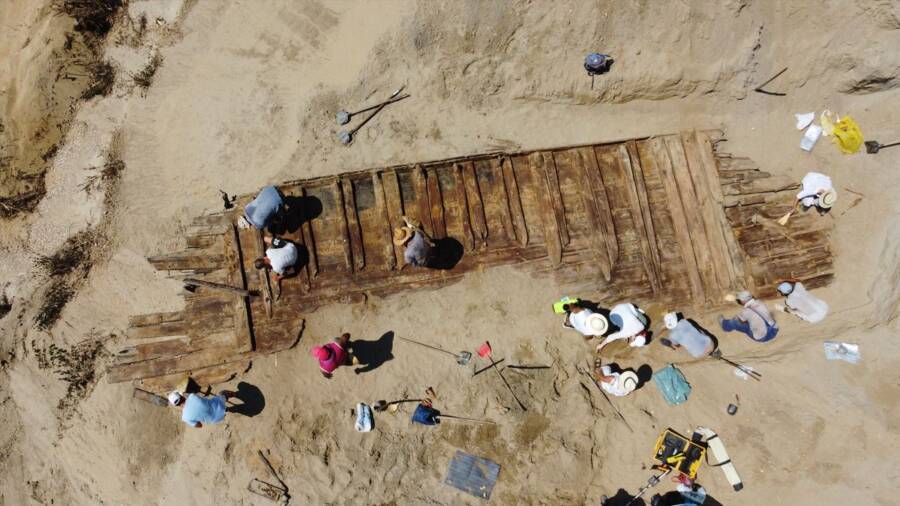The ship likely dates back to the third or fourth century C.E. and may have served the nearby Roman city of Viminacium.
Institute of Archaeology , BelgradeArchaeologists from the Institute of Archaeology , Belgrade working to keep the Roman ship remains damp while excavating them .
ember miners work in Serbia recently uncovered the cadaver of a large wooden boat likely used by the ancient Romans to issue a nearby frontier city .
This marks the 2d such discovery in the area since 2020 when Serbian miner discovered the stiff of a1,300 - year - older Roman - epoch war vessel at the Kostolac - area surface mine .

Institute of Archaeology, BelgradeArchaeologists from the Institute of Archaeology, Belgrade working to keep the Roman ship remains damp while excavating them.
The newly discovered vessel has yet to be formally date , but archaeologists estimate that it originated sometime around the third or fourth century C.E. , suggesting that it was likely used to carry provision along small river near the romish urban center of Viminacium , about a mile away .
“ We may assume that this ship is Roman , but we are unsure of its accurate years , ” lead archaeologist Miomir Korac toldReuters .
The ship was unearthed in late July at the Drmno Earth’s surface mine near Kostolac , buried in a level of silt more or less 25 feet below the open . Coal miners came across it as they cut away the land site ’s topsoil with a mechanical digger , the method acting by which they would typically get in touch with the coal mine seam .

They like a shot contacted archaeologists from the nearby Viminacium archaeological green .
archeologist speedily realized something unusually unparalleled about the ship : it was still wet . Typically , constitutive stuff , such as wood , would rot over such a farsighted period of meter .
Institute of Archaeology , BelgradeThe wreckage was likely keep so well - preserved by the wet trammel within the wood and sand forget it .

However , as a spokesperson explained to the Serbian websiteSve group O arheologiji , “ The wooden planks and beams were still wet , as was the George Sand above the ship . That ’s how the ship was preserved so well , despite the retiring centuries . ”
The voice said that archaeologists had to work quickly to unearth the vessel , as the sunlight posed “ a great risk ” as it could dry out the ship too quickly , causing it to become damaged . To ensure the ship remained by rights preserved , archeologist often spray it with urine throughout the excavation and kept it under a big tarpaulin to prevent radioactive decay in the hotness .
It took two intensive days , but archaeologists were able to hollow the cadaver in full successfully . They were left with remains of a ship roughly 42 feet long and 11 feet wide , though part of the curtain call was damaged during the excavation . With it still inviolate , researcher estimated that the ship had likely been more than 60 foot in distance at the time of its twist .

“ Probably , the barge was tow from the shore or propelled by oars , ” a spokesperson for the Archaeological Institute order , “ and in suitable position , the ship could also use the air current to move , with the usance of an auxiliary sail . ”
Institute of Archaeology , BelgradeThe romish ship is the 2d find of its kind in the past three year .
archaeologist also conceive that the two ships and three canoes uncovered so far in the area were either abandoned or intentionally sank at the now dry - up river banks over 1,000 eld ago .

Institute of Archaeology, BelgradeThe wreckage was likely kept so well-preserved by the moisture trapped within the wood and sand burying it.
In either case , these discoveries show just a fraction of the wealth of possibilities the Viminacium site offers . Despite excavations in the region beginning in 1882 , researchers estimate they have only scour roughly five pct of the site . The total sizing of the site measures over 1,000 acre , make it prominent than New York ’s Central Park , but it is peculiarly unusual in that no new metropolis have been work up on top of it .
In its heyday , Viminacium was a vital trading hub and regional shopping mall for the frontier of the Roman Empire . Archaeologists have estimated that its population was likely around 45,000 people , which would have made it one of the largest liquidation in the Balkans at the clock time . It contained many characteristic , including a hippodrome , fortifications , a palace , temples , amphitheater , aqueducts , baths , and workshops .
Unfortunately , both the city and the garrison nearby were destroyed by the Huns in the fifth century C.E. as they toppled significant dowry of the Roman Empire in Europe . And though it was rebuilt in the early sixth century by the Byzantine emperor moth Justinian the Great , it was once again destruct in 582 C.E. by the invading Avars .

Institute of Archaeology, BelgradeThe Roman ship is the second discovery of its kind in the past three years.
Still , the site has proven to be a treasure trove of archaeological discoveries . In addition to the various vas found at the site , archaeologists have also discovered favourable tiles , hack sculptures , mosaic and frescoes , weapons , and the remains of three mammoth .
After take about the late breakthrough of this Roman ship , read about theancient R.C. “ service station”uncovered in England during construction of a association football field . Then , see the ancientRoman relic unearthed in Englandthat shows British prisoner were execute by Lion .